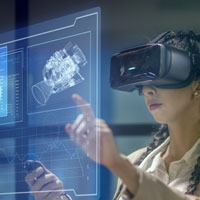Innovating Beyond Boundaries to Advance the Chem-Bio Defense Mission

Our Technologies and Solutions
Demo: CBRN Extended Reality (XR) Training
Noblis Team: Dr. Lance McLean, Jack Daus, Stephanie Andino, Quang Vo, Barry Ross, Jared Haas, Dr. Amanda Fond
Our CBRN XR training application offers a safe-to-fail environment while still providing realism. The scenario shown is a radiation search mission, but this technology can be applied to the entire CBRN field. The app includes features like networked multiplayer (multiple trainees and a trainer), radiation search (detector, place markers, dose stay times), trainer desktop view and after-action reporting.
Download Our PosterDemo: 3D Mapping
Noblis Team: Jack Daus, Dr. Lance McLean, Dr. Amanda Fond, Bay Wiggins
Noblis is developing a prototype application that enables users to automatically create digital 3D scene reconstructions using state-of-the-art machine learning (ML) algorithms. Users capture photos of a scene on their phone and upload the images to the cloud where they are automatically converted into a high-quality 3D model. Using a new technique called 3D Gaussian Splatting, users can view a digital replica of the scene in as little as 30 minutes directly from a web browser. Our research team is continuing to explore extended applications of this technology, including immersive virtual reality (VR), automatic 3D object segmentation and embedded annotations.
Predictive Surveillance of Infectious Disease Outbreaks (PSIDO)
Noblis Team: T.C. Folkedal, Dr. Katharine Jennings, Blaise Arbogast, Dr. Fanwei Zeng, Lauren Moore, Dr. David Ashford, Dr. Loren Shaffer, Dr. Anna Swiatecka
Noblis has developed a model to predict the risk of mosquito blooms correlated with infectious disease outbreaks to improve defense mission readiness and reduce morbidity and mortality. This project aimed to develop and demonstrate a model that accounts for often overlooked weather-related variables associated with arbovirus infectious disease outbreaks. The model provides risk prediction for mosquito blooms likely to coincide with weather sufficiently far enough in advance to enable better preparations and prescriptive actions to mitigate the risks.
Download Our PosterComputer Vision-Enabled Point-of-Care Biothreat Detection
Noblis Team: Dr. Bradley Abramson, Dr. Daniel Negron, Dr. Katharine Jennings, Bryan Necciai, Shanmuga Sozhamannan, Dr. Kelsey Hauser
Fast biothreat detection in resource-constrained environments is essential for fast countermeasure deployment to give warfighters unprecedented advantages. Blindspot Chips and loop-mediated isothermal amplification (LAMP) assays are portable, low-cost solutions for rapid detection of multiple diverse targets simultaneously. These tests, however, are still prone to subjective interpretation, lack clear guidance for next steps and require costly, vendor-specific hardware. Learn how we overcame these challenges and developed an application to analyze solutions using computer vision for in-field interpretation – ultimately enabling faster, easier and more accessible biothreat detection at the point-of-care for our warfighters.
Download Our PosterApplying ML and Statistical Models to Low-Cost Aerosol Sensors for Anomaly Detection
Noblis Team: Dr. Justin Taylor, Brice Ballesteros, Dr. John Helmsen, Dr. Sean Kinahan, Dr. Oscar Olmedo, Cody Rutherford, Ahmid Said, Nathan Spivy, Riley White
The U.S. is investing in multiple programs to improve monitoring for airborne releases of chemical or biological agents using sensors and anomaly-detection data analytics. But common environmental material can emit a signal that increases false alarm rates. Recent developments in ML techniques offer the ability to move from traditional classification of detection events to an approach fusing data from multiple sensors and sources. Using data from the PurpleAir sensor network, Noblis researchers developed synthetic data and overlaid that data with PurpleAir data. Our results show that, overall, smarter data fusion could play a larger role in the spectrum of biological incident detection and response.
Download Our PosterMeet Noblis DTRA CWMD IDIQ Key Personnel
Contact our team at counterWMD@noblis.org.
 COL (Ret) Ben Miller – Director, Countering Weapons of Mass Destruction (CWMD)
COL (Ret) Ben Miller – Director, Countering Weapons of Mass Destruction (CWMD)
Ben is the director for CWMD at Noblis executing a comprehensive and innovative technology and CBRN portfolio across Department of Defense (DOD) programs. He has been a leader in the R&D and CWMD arena for more than 20 years, including as director of the U.S. Army Nuclear & CWMD Agency.
 Dr. Amanda Fond – CWMD Chief Scientist
Dr. Amanda Fond – CWMD Chief Scientist
Amanda is a principal scientist at Noblis with over 20 years of experience in chemical and explosive threat characterization and detection. In her current role, she works as a subject matter expert and program coordinator for DoD and has previously worked with the DHS Science and Technology Directorate’s Mission Capability Support Office for their Homemade Explosive Identification, Detection and Mitigation strategic program.
 Dr. Katharine Jennings – CWMD Domain Lead
Dr. Katharine Jennings – CWMD Domain Lead
Katharine is a senior manager on the Life Sciences Team, a group of Noblis biologists and data scientists who are applying biology, bioinformatics and cutting-edge computational capabilities to solve diverse, real-world problems in public health and national security. She has more than 20 years of experience focusing on microbial forensics, biodefense and professional development training.
 Dr. Lance McLean – CWMD Domain Lead
Dr. Lance McLean – CWMD Domain Lead
Lance has over 10 years of experience in counterterrorism and crisis response missions across multiple science disciplines and planning and training for responses to radiologic events. In his current role, he is a project manager and trusted advisor providing analysis, advice and training for DOE, DOD and DHS programs.
Why Noblis
Research & Development for the Best of Reasons
Noblis’ labs and research centers are at the heart of our work. They provide a place for our interdisciplinary teams to explore and develop the disruptive capabilities, breakthrough innovations and transformative scientific discoveries that fuel the technological and engineering solutions we deliver today and anticipate for tomorrow across the civil, defense, homeland security, intelligence, space and health missions we serve.


Investing in the Future
From enabling DoD to detect and deter strategic attacks, address WMD threats and overcome adversaries to leveraging AI/ML to improve public health and safety outcomes, Noblis’ research has lasting mission impacts. Through our internal Noblis Sponsored Research program, we employ an enterprise-wide ideation process to develop and invest in possibilities. We use our own insights, time and funding to transform novel ideas and inventions into practical, sustainable solutions that meet tomorrow’s challenges.
Collaborating for Lasting Impacts
We work together as one team collaborating on multiple technologies, domains and missions across our organization. In addition, as an innovation gateway, we purposely engage with industry, the research community and our customers to solve the most unique and critical challenges.






